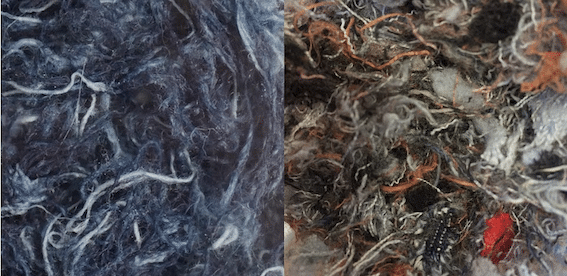Reducing the use of plastic and producing more natural alternatives remains the fundamental challenge of the ecological transition. It is also the issue of circularity and waste management in order to avoid mass production which has had a considerable impact on the environment and its various ecosystems.
The fashion industry produces an astronomical volume of more than 100 billion garments each year. 60 per cent of these are made with fossil fuels (plastic) and 85 per cent will end up in a landfill before the year is out. This being the case, it is imperative that we rethink our clothing needs and adopt a much more sober attitude towards our consumption.
Mycelium for biodegrading plastic molecules?
If fungi, and more specifically their mycelium, are able to biodegrade the main components of textiles (cellulose and in some cases more complex plastic molecules), it is therefore possible to rethink the linearity of the textile industry. Beyond the decomposition of waste, the mycelium (“roots” of fungi) can produce mycelium-based materials, which have a leather-like appearance for use in fashion.
Annah-Ololade Sangosanya has investigated this as a way of offering fashion an alternative that is both sustainable and environmentally friendly. She first studied biological engineering (M. eng in biology, INSA Toulouse) and more particularly microbiology and genetic engineering. Passionate about the environment and fashion, she uses her knowledge for sustainable purposes and wishes to contribute to a better and less polluting world. With her master’s degree in hand, she went to Barcelona to study at the Fabricademy, where she learned how to use new technologies, biology and digital manufacturing (3D design, rapid prototyping, electronics) to develop a more sustainable textile design and start her project: The Purhyphae Project.
What is The Purhyphae Project?
In her final year project, The Pure Hyphae Project (or Purhyphae Project), Annah-Ololade investigated the biodegradation of textile waste using mycelium and succeeded in combining biology, textile design and sustainability. The results of these very promising experiments led her to a new flexible composite material based on mycelium, textile waste and coffee grounds, which requires only waste, very few resources and little energy to grow.
Flexible leather-like mycelial materials
In her study, Annah Ololade succeeded in producing flexible mycelial materials by biodegrading various combinations of denim textile waste, synthetic textile waste, food waste and used coffee grounds.


The mycelium used is from the oyster mushroom (Pleurotus ostreatus). The results show that the mycelium of P. ostreatus (oyster mushroom) grows on all combinations of food waste (vegetable peelings and coffee grounds) with textile waste (synthetic textiles and denim textiles) and even on denim textile waste only.
“In my experiments, I observed that the mycelium did not fully degrade the fibres, but only partially digested them, resulting in a composite of the mycelium and the rest of its substrate. Given the flexible nature of the substrate, the composite of textile and food waste mycelium is also malleable, and therefore interesting for potential textile applications,” explains Annah-Ololade.
Circularity to reduce environmental problems
A soft composite post-treatment protocol using low energy and natural components (heat, water, glycerol and beeswax) was created to make a leather-like composite fungal material.“The whole process of partial biodegradation of textile and food waste mixtures, followed by post-treatment, is a sustainable process. It could allow textiles to be processed in a circular way and therefore close the loop of the current linear model, offering the possibility of disposing of poorly recycled waste and reducing the associated environmental impacts,” she adds. « This project is still in the research and development phase. I am currently working on defining and improving the efficiency of this process to see if commercial operation is possible. »
How does it work ?
More concretely, textile waste is shredded and mixed with ground coffee waste, moistened, placed in a Petri dish* and sterilised in an autoclave**. Once sterilised, the mixture is inoculated with mycelium and placed in an incubator at 30°C, with high humidity. Once the mycelium has colonised the entire substrate, it can be processed into a composite material. The composite is hot-pressed, plasticised in a glycerol bath and coated with wax.
*A transparent shallow cylindrical glass box with a lid
**High-temperature, high-pressure sterilisation instrument.
Pictures : Annah-Ololade Sangosanya







